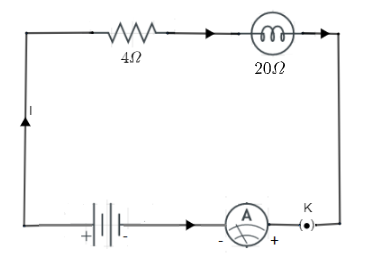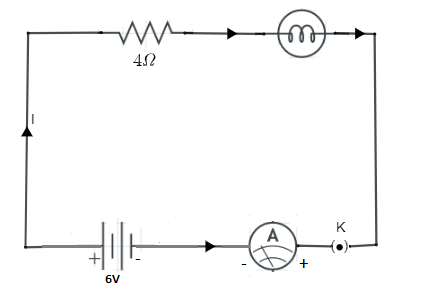
Answer
423.3k+ views
Hint: First we have to calculate resistance using the series rule and using total resistance we can calculate total current in the circuit and by using value of the current we can calculate potential difference across the electrical lamp and the conductor and we can calculate power using total current in the circuit and the voltage.
Formula used:
$\begin{align}
& I=\dfrac{V}{R} \\
& P=\dfrac{V}{I} \\
\end{align}$
Complete step by step solution:

(A) The total resistance of the circuit:
As we can see in the circuit that electric lamp with the resistance 20Ω and the conductor 4Ω are connected in the series, So that we can apply series rule of resistance.
Now total resistance of the circuit:
$\begin{align}
& R=20+4 \\
& R=24\Omega \\
\end{align}$
Hence the total resistance of the circuit is 24Ω.
(b) The current through the circuit:
We know that formula for the current (I) :
$\Rightarrow I=\dfrac{V}{R}....\left( 1 \right)$
Where, I = current
V = Voltage applied
R = total resistance
Here voltage is given as,
V = 6V
And the total resistance
R = 24Ω
Now current,
$\begin{align}
& I=\dfrac{6}{24} \\
& \therefore I=0.25A \\
\end{align}$
Hence current through the circuit is 0.25A.
(c) The potential difference across the
(i) Electric lamp.
If the potential difference across the electric lamp is Ve and the resistance of the electric lamp Re then,
$\begin{align}
& \Rightarrow Ve=I\times \operatorname{Re} \\
& \Rightarrow Ve=0.25\times 20 \\
& \therefore Ve=5V \\
\end{align}$
Hence the potential difference across the electric lamp is 5V.
(ii) The potential difference across the conductor.
If the potential difference across the conductor is Vc and resistance of the conductor is Rc then,
$\begin{align}
& \Rightarrow Vc=I\times Rc \\
& \Rightarrow Vc=0.25\times 4 \\
& \therefore Vc=1V \\
\end{align}$
(D) Power of the lamp:
Formula for the power,
\[P\text{ }=\text{ }\dfrac{\text{voltage across the lamp }\left( \text{Ve} \right)}{\text{current through lamp (I)}}\]
Where, P is power
$\begin{align}
& \Rightarrow P=\dfrac{5}{0.25} \\
& \therefore P=20W \\
\end{align}$
Note:
Here in the option (d) when we calculate power of the lamp don’t put the voltage as the total applied voltage instead of the voltage across the lamp (Ve) that we find in the option (c).
Formula used:
$\begin{align}
& I=\dfrac{V}{R} \\
& P=\dfrac{V}{I} \\
\end{align}$
Complete step by step solution:

(A) The total resistance of the circuit:
As we can see in the circuit that electric lamp with the resistance 20Ω and the conductor 4Ω are connected in the series, So that we can apply series rule of resistance.
Now total resistance of the circuit:
$\begin{align}
& R=20+4 \\
& R=24\Omega \\
\end{align}$
Hence the total resistance of the circuit is 24Ω.
(b) The current through the circuit:
We know that formula for the current (I) :
$\Rightarrow I=\dfrac{V}{R}....\left( 1 \right)$
Where, I = current
V = Voltage applied
R = total resistance
Here voltage is given as,
V = 6V
And the total resistance
R = 24Ω
Now current,
$\begin{align}
& I=\dfrac{6}{24} \\
& \therefore I=0.25A \\
\end{align}$
Hence current through the circuit is 0.25A.
(c) The potential difference across the
(i) Electric lamp.
If the potential difference across the electric lamp is Ve and the resistance of the electric lamp Re then,
$\begin{align}
& \Rightarrow Ve=I\times \operatorname{Re} \\
& \Rightarrow Ve=0.25\times 20 \\
& \therefore Ve=5V \\
\end{align}$
Hence the potential difference across the electric lamp is 5V.
(ii) The potential difference across the conductor.
If the potential difference across the conductor is Vc and resistance of the conductor is Rc then,
$\begin{align}
& \Rightarrow Vc=I\times Rc \\
& \Rightarrow Vc=0.25\times 4 \\
& \therefore Vc=1V \\
\end{align}$
(D) Power of the lamp:
Formula for the power,
\[P\text{ }=\text{ }\dfrac{\text{voltage across the lamp }\left( \text{Ve} \right)}{\text{current through lamp (I)}}\]
Where, P is power
$\begin{align}
& \Rightarrow P=\dfrac{5}{0.25} \\
& \therefore P=20W \\
\end{align}$
Note:
Here in the option (d) when we calculate power of the lamp don’t put the voltage as the total applied voltage instead of the voltage across the lamp (Ve) that we find in the option (c).
Recently Updated Pages
what is the correct chronological order of the following class 10 social science CBSE

Which of the following was not the actual cause for class 10 social science CBSE

Which of the following statements is not correct A class 10 social science CBSE

Which of the following leaders was not present in the class 10 social science CBSE

Garampani Sanctuary is located at A Diphu Assam B Gangtok class 10 social science CBSE

Which one of the following places is not covered by class 10 social science CBSE

Trending doubts
Which are the Top 10 Largest Countries of the World?

The states of India which do not have an International class 10 social science CBSE

The Equation xxx + 2 is Satisfied when x is Equal to Class 10 Maths

How do you graph the function fx 4x class 9 maths CBSE

One Metric ton is equal to kg A 10000 B 1000 C 100 class 11 physics CBSE

Difference Between Plant Cell and Animal Cell

Fill the blanks with the suitable prepositions 1 The class 9 english CBSE

Why is there a time difference of about 5 hours between class 10 social science CBSE

Name the three parallel ranges of the Himalayas Describe class 9 social science CBSE




